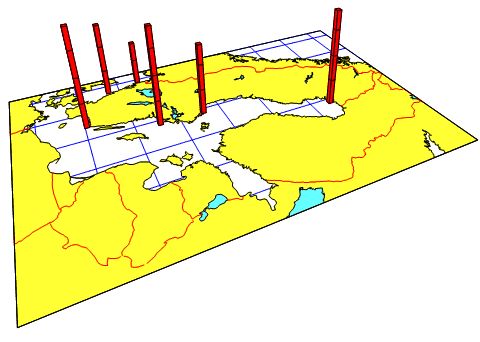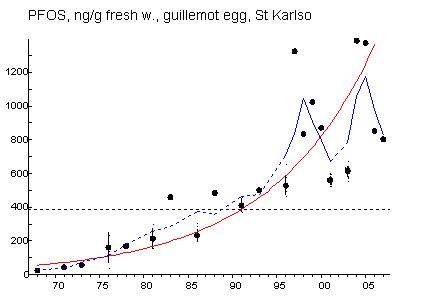Perfluorooctane sulfonate (PFOS) concentrations in fish liver and guillemot egg

|
||||
Key message
The concentration of PFOS in Guillemot egg shows a significant increase of 7-10% for the whole time period, which is equal to 25-30 times higher levels in the early 2000s than in the late 1960ties. However, during the last ten year no trend could be observed. Due to change of the analytical method between 2003 and 2004 and relatively high inter-annual variations during the last ten years, the future trend for PFOS concentrations in the Baltic marine environment cannot be predicted. However, due to the long environmental half-live of PFOS it cannot be expected that levels will decrease rapidly.
So far only three years (2005-07) of analysis in herring liver are available (pooled samples, 10 fish in each). Therefore, the obtained results have to be interpreted carefully.

Figure 1. Spatial variation in geometric mean concentration (the annual mean values, 2005-2007) (ng/g fresh w.) of PFOS in herring liver. The highest concentration (9.6 ng/g) was found at Utlängan in the southern parts of the Baltic Proper, the lowest (4.3 ng/g) at Väderöarna in Skagerrak. Data originates from the Swedish national monitoring programme, and analyses were performed at the Department of Applied Environmental Science, University of Stockholm.
Results and assessments
Relevance of the indicator for describing developments in the environment
Analyses of contaminants in biotic samples, in contrast to abiotic matrices, exhibit the bioavaliable part of the contaminants i.e. the part that has virtually passed through the biological membranes and may cause toxic effects.
Policy relevance and policy references
PFOS has been produced and used since the 1950s, but due to findings of detectable concentrations in human blood in the general population and negative health effects on living organisms, PFOS has been phased out in 2002 by its main producer 3M.
The HELCOM Ministerial Declaration from 1988 called for a reduction of stable organic substances by 50% by 1995 with 1987 as a base year. The HELCOM Ministerial Declaration from 1996 and the Esbjerg declaration 1995, call for measures for toxic, persistent, bioaccumulating substances to have ceased completely in the year 2020. In the Baltic Sea Action Plan PFOS and perfluorooctanoate (PFOA) have been identified as substances of specific concern to the Baltic Sea.
Assessment
The distribution of PFOS in herring liver from all herring sites in the Baltic and at the Swedish West coast is quite homogenous along the Swedish coast, which is a result of the extraordinary persistency of this compound and the long history of use (three decades). The highest concentration (2005-2007) (9.6 ng/g) was found at Utlängan in the southern parts of the Baltic Proper, the lowest (4.3 ng/g) at Väderöarna in Skagerrak. The tentatively lower concentrations at the Swedish West coast might reflect dilution through water exchange compared to the almost enclosed Baltic Sea with a very long water residence time.
The guillemot eggs time-series from St. Karlsö in the Baltic Proper shows a significant increasing trend of 7-10% per year (1968-2007).

Figure 2. Temporal trend of PFOS concentration (ng/g fresh w.) in guillemot eggs (1968-2007). The red line presented in the figure is based on a log-linear regression analysis and shows an increasing trend of 7-10 % per year and the blue line is a simple 3-point running mean smoother fitted to the annual geometric mean values. The horizontal dotted line is the mean concentration over the whole period.
References
Bignert, A., Danielsson S., Strandmark A., Nyberg E., Asplund L., Eriksson U., Wilander A. Haglund P. 2008. Comments Concerning the National Swedish Contaminant Monitoring Programme in Marine Biota. Report to the Swedish Environmental Protection Agency, 2008. 128 pp.
Data
Trend (in %) assessed from the annual geometric mean of concentrations of PFOS (ng/g fresh weight) in guillemot egg at St. Karlsö during the time period 1968-2007 and the estimated mean concentration for the last year (2007). The total number of analyses and the number of years are also presented. The numbers presented in brackets are the 95% confidence intervals.
| Matrix | n analyses | n yrs | year | trend (95% ci) | mean concentration of last year (95% ci) |
| Guillemot egg | |||||
| St. Karlsö | 80 | 22 | 68-07 | 8.4 (6.7,10)* | 1475 (1057-2059) |
* significant trend, p < 0.05.
Metadata
Technical information
Data source: The ICES database and results from the National Swedish Monitoring Program of Contaminants in Biota
Sampling, sample preparation, storage in specimen bank and evaluation of results are carried out by the Department of Contaminant Research at the Swedish Museum of Natural History, Stockholm. Chemical Analysis is carried out at the Department of Applied Environmental Science at Stockholm University.
Geographical coverage: see data table and map.
Temporal coverage: see data table and figures.
Methodology and frequency of data collection, see Bignert et al, 2008
Methodology of data manipulation. For a detailed description of statistical methods used, see Bignert et al. 2008.
Quality information
The number of years required to detect an annual change of 5% with a power of 80% was 21 years for the guillemot time-series.
For reference purposes, please cite this indicator fact sheet as follows:
[Author’s name(s)], [Year]. [Indicator Fact Sheet title]. HELCOM Indicator Fact Sheets 2008. Online. [Date Viewed], http://www.helcom.fi/environment2/ifs/en_GB/cover/.
Last updated: 27 January 2009

